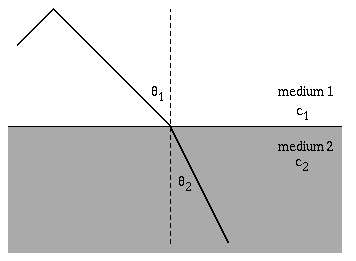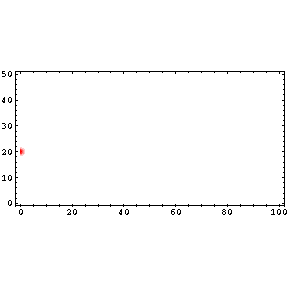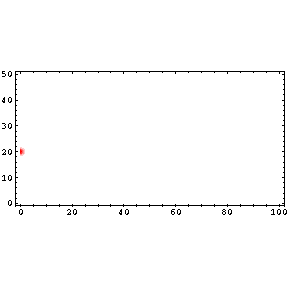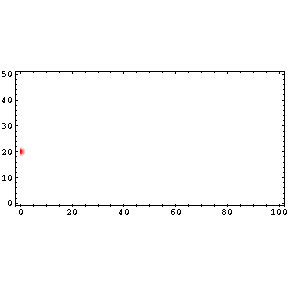|
Suppose you are camping on the shore of a lake which is not too wide, maybe 1/2 a mile across or so. During the day you can see campers on the other side of the lake, but you cannot hear them. At night, however, you can not only see the campers on the other side of the lake but you can also hear their conversations as they sit around their camp fire. This phenomena is due to the refraction of sound waves.
The speed of a wave depends on the elastic and inertia properties of the medium through which it travels. When a wave encounters different medium where the wave speed is different, the wave will change directions.
 Most often refraction is encountered in a study of optics, with a ray of light incident upon a boundary between two media (air and glass, or air and water, or glass and water). Snell's law relates the directions of the wave before and after it crosses the boundary between the two media.
Most often refraction is encountered in a study of optics, with a ray of light incident upon a boundary between two media (air and glass, or air and water, or glass and water). Snell's law relates the directions of the wave before and after it crosses the boundary between the two media.
 Notice that as the wavefronts cross the boundary the wavelength changes, but the frequency remains constant.
Notice that as the wavefronts cross the boundary the wavelength changes, but the frequency remains constant.
|

In the above animation a spherical wave pulse propagates in a medium where the wave speed is constant in all directions. The wave expands outwards as an ever expanding circle, with the wave traveling at the same speed in all directions. Since the wave speed is the same everywhere, there is no refraction, and the wave does not change direction as it propagates.
|
|
In acoustics, however, sound waves usually don't encounter an abrupt change in medium properties. Instead the wave speed changes gradually over a given distance. The speed of a sound wave in air depends on the temperature (c=331 + 0.6 T) where T is the temperature in oC. Often the change in the wave speed, and the resulting refraction, is due to a change in the local temperature of the air. For example, during the day the air is warmest right next to the ground and grows cooler above the ground. This is called a temperature lapse. Since the temperature decreases with height, the speed of sound also decreases with height. This means that for a sound wave traveling close to the ground, the part of the wave closest to the ground is traveling the fastest, and the part of the wave farthest above the ground is traveling the slowest. As a result, the wave changes direction and bends upwards. This can create a "shadow zone" region into which the sound wave cannot penetrate. A person standing in the shadow zone will not hear the sound even though he/she might be able to see the source. The sound waves are being refracted upwards and will never reach the observer.

|

The animation above shows the propagation of a spherical wave pulse in a medium where the wave speed in the x-direction is constant, but where the speed in the vertical y-direction decreases with height
(c = 1 - 0.05y) As a result the wave changes direction and bends upwards.
|
|
A temperature inversion is when the temperature is coolest right next to the ground and warmer as you increase in height above the ground. Since the temperature increases with height, the speed of sound also increases with height. This means that for a sound wave traveling close to the ground, the part of the wave closest to the ground is traveling the slowest, and the part of the wave farthest above the ground is traveling the fastest. As a result, the wave changes direction and bends downwards. Temperature inversions most often happen at night after the sun goes down when the ground (or water in a lake) cools off quickly, while the air above the ground remains warm. This downward refraction of sound is why you can hear the conversations of campers across the lake, when otherwise you should not be able to hear them. (remember that they can probably hear you too!)

|

The animation above shows the propagation of a spherical wave pulse in a medium where the wave speed in the x-direction is constant, but where the speed in the vertical y-direction increases with height
(c = 1 + 0.05y) As a result the wave changes direction and bends downwards.
|


 Most often refraction is encountered in a study of optics, with a ray of light incident upon a boundary between two media (air and glass, or air and water, or glass and water). Snell's law relates the directions of the wave before and after it crosses the boundary between the two media.
Most often refraction is encountered in a study of optics, with a ray of light incident upon a boundary between two media (air and glass, or air and water, or glass and water). Snell's law relates the directions of the wave before and after it crosses the boundary between the two media.





